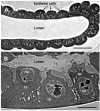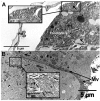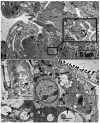Tissue tropism of the Musca domestica salivary gland hypertrophy virus
- PMID: 20600389
- PMCID: PMC2956836
- DOI: 10.1016/j.virusres.2010.06.015
Tissue tropism of the Musca domestica salivary gland hypertrophy virus
Abstract
The tissue tropism of Musca domestica salivary gland hypertrophy virus (MdSGHV) infecting adult house flies was examined by transmission electron microscopy (TEM) and quantitative real-time PCR. TEM demonstrated that characteristic MdSGHV-induced nuclear and cellular hypertrophy was restricted to the salivary glands. Both nucleocapsids and enveloped virions were present in salivary gland cells. In contrast, thin sections of midguts, ovaries, abdominal fat body, crops, air sacs and brains showed the presence of enveloped virions in vacuoles of tracheal cells associated with these tissues. However, no sites of viral morphogenesis were detected in the tracheal cells. Quantitative analysis of MdSGHV DNA and transcript titers revealed that viral DNA was present in all hemolymph and tissue samples collected from MdSGHV-infected flies. Average numbers of MdSGHV genome copies per 50 ng of DNA varied significantly between examined tissues and ranged from 3.83 × 10(8) (±3.75 × 10(7)) in salivary gland samples to 7.98 × 10(5) (±2.91 × 10(5)) in hemolymph samples. High levels of viral genome copies were detected in midgut, fat body and brain samples. Viral transcripts were present in all examined samples, and transcript abundance was also at the highest level in salivary glands and at the lowest level in hemolymph. However, over the range of different tissues that were analyzed, there was no correlation between estimated quantities of genome copies and viral transcripts. The function of viral transcripts in host tissues that do not show sites of viral morphogenesis remains to be elucidated.
Copyright © 2010 Elsevier B.V. All rights reserved.
Figures





References
-
- Abd-Alla A, Vlak JM, Bergoin M, Maruniak JE, Parker A, Burand J, Jehle JA, Boucias D. Hytrosaviridae: a proposal for classification and nomenclature of a new insect virus family. Arch Virol. 2009;154(6):909–918. - PubMed
-
- Adams TS, Gerst JW, Masler EP. Regulation of ovarian ecdysteroid production in the housefly, Musca domestica. Arch Insect Biochem Physiol. 1997;35(1–2):135–148.
-
- Amargier A, Lyon JP, Vago C, Meynadier G, Veyrunes JC. Mise en evidence et purification d’un virus dans la proliferation monstreuse glandulaire d’insectes. Etude sur Merodon equestris (Diptera, Syrphidae) Note Comp Rend Seanc Acad Sci Ser D Sci Natur. 1979;289:481–484. - PubMed
-
- Cody RP, Smith JK. Applied statistics and the SAS programming language. Pearson Prentice Hall; Upper Saddle River: 2006.
Publication types
MeSH terms
Grants and funding
LinkOut - more resources
Full Text Sources

